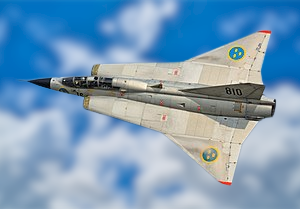After Russia's invasion of Ukraine, Sweden is thinking of joining NATO. Observing a Swedish cold war plane developed to stand up to the Ussr is instructive.
The (SAAB) 35 Draken Fighter is a strike aircraft manufactured by (SAAB)
Sweden was neutral at the time, but its military was afraid that if the Soviets violated Swedish airspace in a dangerous manner, it would have a spillover effect. As a result, the Saab 35 Draken fighter has a unique and intriguing design.
Late in the 1940s
Sweden needed a fast fighter interceptor that could rise swiftly against enemy bombers in the late 1940s. Large armament store, lengthy endurance, and the ability to take off from short runways were all required.
Engineers and technicians from Sweden
Engineers and technicians in Sweden had an idea for a new design feature. They came up with a unique double delta wing design that set the Draken apart from other fighters at the time. This was a huge step forward in terms of what fighter jets could do at the time.
Delta Wings in a Pair
The wing design was defined as two paired delta wings functioning in tandem by the military factory. One pair swung forward at a steeper angle, whereas the other pair swung ahead with a more progressive slant. A single vertical tail was matched with this. Even though Draken translates to dragon, this shape resembled a kite during the 1950s, and it preserved the nickname. The wings increased speed and manoeuvrability while also allowing more fuel and armaments to be carried. The Draken's air intakes with elliptical apertures allowed one prototype to break the sound barrier on an ascent in the mid-1950s, demonstrating that the Draken's design was favourable.
The Super Stalled Airplane
However, the plane would occasionally hyper stall. The test pilots were focused on creating manoeuvres that would avoid these dangers, such as a quick loss of height owing to instability. This learning curve was not cheap. A total of 179 Draken super stalls occurred, resulting in 35 crashes and the deaths of four pilots.
Other Countries' Exports
Since the Draken was exported to Finland, Austria, and Denmark, more pilots had to be educated on how to avoid dangerous altitude losses. Finally, pilots learned the cobra manoeuvre, which is a technically hard aerobatic show in which a quick lift of the nose leads an aeroplane to fly forward perpendicular to the ground, according to national interest. While facing the sky, a pilot temporarily converts the airframe into a massive air brake, causing the plane to swiftly slow down.
A total of 651 planes were built
Over the decades, 651 of the planes were constructed, and it became the Swedish air force's principal fighter interceptor. It was the first plane manufactured in Europe to achieve Mach 2. The Draken never saw war, but in a dogfight with Soviet aircraft, it would have done well.
It was armed with a variety of weapons
It was armed with cannons, bombs, and sidewinder air-to-air missiles, among other things. Despite the risk of super stalls, the Draken had a good reputation, and Austria kept them in service until 2005, giving them a 50-year flying career. The innovative double delta wings' original Swedish designers probably had no idea how durable they would be.










0 Comments